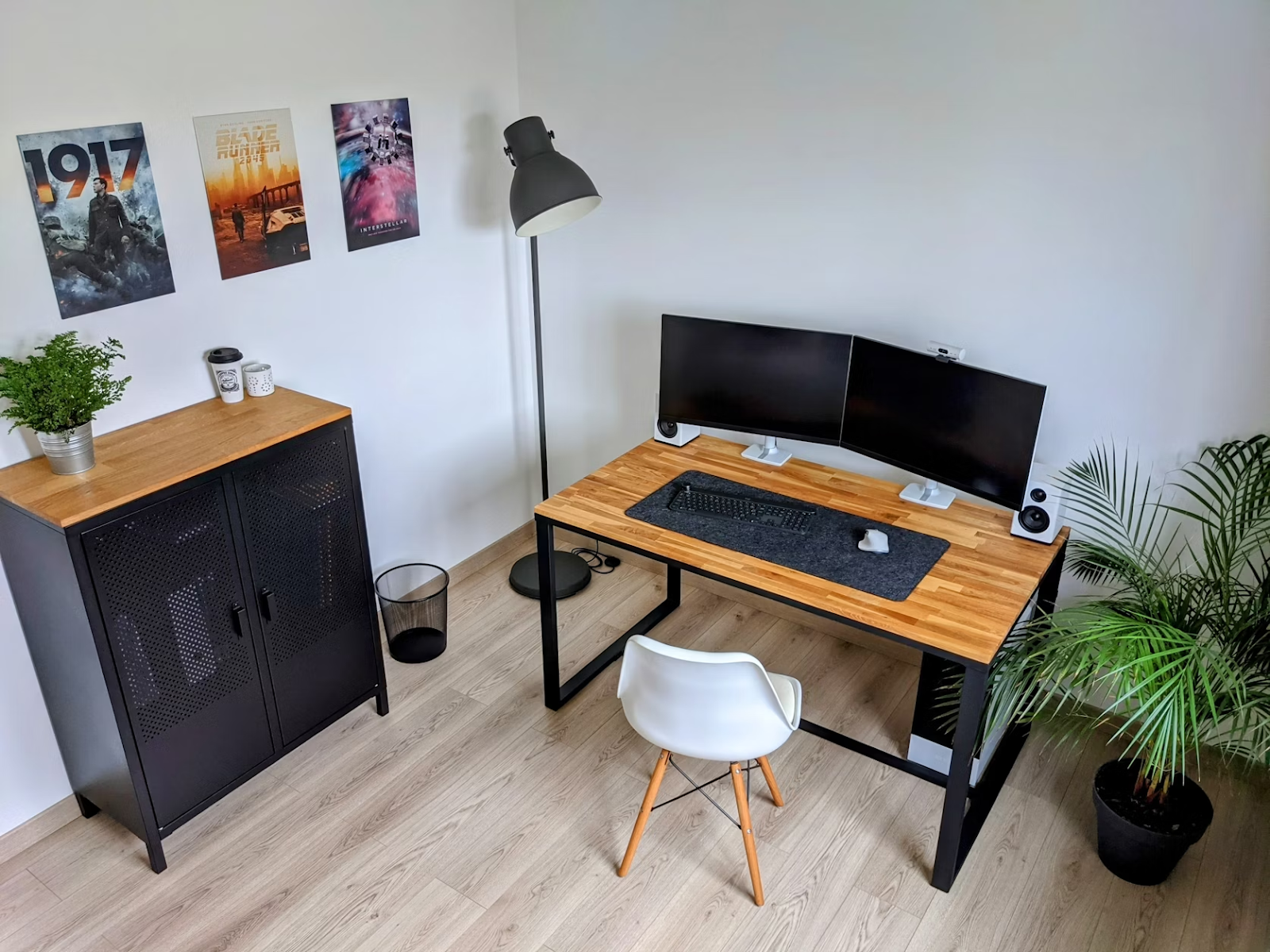The workforce is undergoing rapid change, leaving many employees uncertain — yet most remain resilient and eager to adapt. This openness to new ways of working is vital as innovation, sustainability, consumer demand, and employee experience reshape business.
Strong leadership and transparency are key to guiding teams through transformation. Clear communication helps employees feel valued, engaged, and aligned with organizational goals.
Meanwhile, emerging technologies and global pressures demand agility. Businesses must continuously reinvent strategies, manage risks, and embrace change — not just to survive, but to thrive.
Small but impactful shifts, from lifestyle choices to business practices, are driving meaningful outcomes and shaping the future of how we live, work, and trade.
Changing Spaces at Home
Source: https://unsplash.com/photos/a-desk-with-a-computer-on-top-of-it-V6WwLvSs_Fs
In the quest for more functional and design-forward homes, homeowners are increasingly seeking ways to achieve the right balance between aesthetics and practicality. The modern home is no longer just a place to live; it’s a sanctuary that reflects personal style and meets the demands of everyday life.
One of the standout trends in home design is the rise of high-quality surfaces. Modern porcelain panel benchtops, for instance, are becoming a popular choice for kitchen and living space upgrades. These benchtops are not only stylish but also incredibly durable, offering a perfect blend of beauty and functionality. Homeowners are drawn to these surfaces for their sleek appearance and practicality, making them a staple in contemporary home design.
As people seek ways to enhance their living spaces, the focus is on creating environments that are both beautiful and functional. Multipurpose rooms, modular furniture, and flexible living spaces are becoming increasingly popular as they cater to the evolving needs of homeowners. These design choices allow for greater versatility, making it easier to adapt spaces to different functions and activities.
Incorporating these trends into home design is not just about following the latest fads. It’s about creating spaces that are comfortable, efficient, and reflective of personal taste. Investing in high-quality materials and thoughtful design can transform living spaces into havens of style and practicality.
Creating Healthier Living Environments
Source: https://unsplash.com/photos/a-wooden-table-topped-with-potted-plants-next-to-a-window-JOSiIdfOJJM
Health and wellness have become paramount in today’s households, with a growing emphasis on creating environments that promote physical and mental well-being. A key aspect of this trend is the focus on clean living, including safe and sustainable water. Water filtration systems have emerged as practical technology that supports long-term well-being in everyday life, ensuring that households have access to clean and safe drinking water.
Sustainability in home design is also gaining traction, with eco-friendly materials and energy-efficient appliances becoming standard features in modern homes. These choices not only reduce the environmental impact but also contribute to a healthier living environment. Prioritizing sustainability allows homeowners to make meaningful changes benefiting both their health and the planet.
Biophilic design is another trend that emphasizes the connection between nature and well-being. Incorporating natural elements like indoor gardens and green walls can create a calming atmosphere and enhance mental health. These design choices bring a human touch to living spaces, making them more inviting and serene.
Smart technology is playing an increasingly important role in creating healthier living environments. Automated systems for lighting, heating, and security enable people to automate tasks and manage their homes more efficiently and conveniently. These technologies contribute to a comfortable and safe living environment, allowing homeowners to focus on what matters most.
Personalization and Aesthetic Improvements
Source: https://unsplash.com/photos/a-white-couch-with-two-pillows-on-it-aHKEJMDYRMk
Personalization is at the heart of modern living, with homeowners investing in local expertise to refresh their spaces and bring personality and character into their homes. The demand for skilled professionals, such as painters in Adelaide, is on the rise as people seek ways to make their living spaces uniquely their own.
AI tools and AI technology advancements are enabling homeowners to achieve a high degree of personalization in their home improvements. Key aspects include:
- Generative AI and large language models are becoming useful tools in designing customized interiors that reflect individual tastes and preferences.
- These technologies allow for precise and tailored design solutions.
- They enhance the overall aesthetic appeal of homes.
The adoption of AI in home design is not just about aesthetics; it’s also about improving functionality. AI performance in optimizing space usage and suggesting practical design elements ensures that homes are both beautiful and efficient. AI adoption of these advancements helps homeowners create living spaces perfectly suited to their lifestyles.
The growing demand for personalized home improvements underscores the importance of skilled workers who can bring these visions to life. From painters to interior designers, local expertise plays a key role in transforming ordinary spaces into extraordinary ones. This trend highlights the shift towards more personalized and aesthetically pleasing living environments.
Smarter Approaches to Business Operations
Efficiency in logistics and e-commerce is reshaping the way businesses operate, driven by the need to meet consumer expectations for faster delivery and accuracy. Streamlined pick and pack services have become essential in helping businesses achieve these goals, ensuring that products are delivered swiftly and accurately to customers.
Generative AI is transforming supply chain management by leveraging ai and artificial intelligence to analyze vast amounts of data to improve operational efficiency. AI-driven low-touch planning reduces the need for manual input in supply chain processes, enhancing accuracy and efficiency. These advancements enable businesses to optimize their operations and stay competitive in a fast-paced market.
Data fragmentation continues to be a major barrier in supply chain management, necessitating a focus on improving data quality and availability. Transparency in the supply chain is also increasingly important, extending beyond immediate suppliers to aid in risk identification and compliance. Addressing these challenges enables businesses to achieve better organizational success and improve outcomes.
The adoption of new technologies, such as low-code platforms and electric vehicles, is further enhancing operational efficiency in the logistics sector. These innovations empower employees to adapt quickly to changing demands and increase productivity. As businesses continue to leverage AI and other technologies, they can achieve goals and maintain a competitive edge in the market.
Shifts in Consumer Trends and Lifestyle Products
Cultural and retail trends are evolving, with consumers increasingly drawn to unique and meaningful products. This shift is reflected in the growing popularity of alternative wellness and decorative products, such as wholesale crystals. These items are gaining traction in both personal lifestyles and retail markets, as people seek authenticity and individuality in what they buy.
The demand for personalized shopping experiences has surged, with a significant percentage of digitally engaged consumers wanting tailored products or services. This trend is driving brands to focus on offering multifunctional beauty and personal care products that provide cost-effective solutions without compromising on quality. Catering to these preferences helps companies stay relevant and meet consumer expectations.
Health consciousness is another driving demand factor in consumer trends, with a growing number of people gravitating towards foods and drinks that offer health benefits. This shift reflects a broader desire for products that support overall well-being and a healthier lifestyle. Companies are responding to this demand by offering products that are both nutritious and appealing.
Sustainable consumption is also a key trend, with more than 60% of consumers expressing a desire to positively impact the environment. Brands are investing in transparency regarding their sustainability claims to regain consumer trust and address skepticism about greenwashing. By prioritizing sustainability, companies can build stronger relationships with their customers and drive demand for their products.
Looking Ahead to the Future of Work and Living
The future of work and living will be shaped by innovations in design, health, trades, logistics, and consumer goods — focused not on luxury, but on resilience, comfort, and efficiency.By 2030, AI and automation will transform job roles, making reskilling and continuous learning essential. Employers are prioritizing skills-based hiring and technical training to close gaps and build an adaptable, inclusive workforce.
Demographic shifts — rising living costs, aging populations in developed nations, and younger populations in developing regions — will drive demand for healthcare and education jobs. At the same time, diversity, equity, and inclusion initiatives are becoming central to talent retention and building supportive workplace cultures.
Conclusion
Today’s world of work, life, and trade is being reshaped by innovation, sustainability, and shifting consumer demand. From smarter homes to more efficient business operations, adaptability and resilience are at the core of progress.
Design-forward living spaces, wellness-focused lifestyles, and AI-driven business strategies reflect the need for efficiency, comfort, and alignment with modern values. Small yet meaningful changes — whether in daily living or supply chain management — are paving the way for a future where innovation and sustainability go hand in hand.
By embracing these trends and prioritizing continuous learning, we can build a resilient, thriving, and sustainable future for generations to come.
Frequently Asked Questions
What are the key trends shaping modern lifestyles and business practices?
The key trends shaping modern lifestyles and business practices are innovation, sustainability, heightened consumer demand, a focus on health and wellness, advancements in AI and technology, and the rise of personalized shopping experiences. These trends reflect a shift towards more responsible and tailored approaches in both personal and commercial domains.
How are homes becoming more functional and design-forward?
Homes are increasingly designed to blend aesthetics with functionality, featuring high-quality surfaces and multipurpose areas that promote flexibility. This approach allows homeowners to create spaces that are both visually appealing and practical for everyday living.
What role does AI play in home personalization?
AI plays a crucial role in home personalization by optimizing space usage and suggesting design elements that enhance aesthetics and functionality. This technology allows homeowners to achieve tailored improvements that truly reflect their individual preferences.
How are businesses optimizing their operations in the current landscape?
Businesses are optimizing their operations by embracing AI technology, generative AI, and low-code platforms to streamline supply chain management and enhance efficiency. Additionally, the adoption of electric vehicles and automation in logistics is further contributing to improved operational effectiveness.
What are the major consumer trends in 2024?
In 2024, consumers are expected to prioritize unique and meaningful products, seek personalized shopping experiences, focus on health-conscious foods and beverages, and emphasize sustainable consumption. These trends reflect a growing desire for individuality and responsibility in purchasing decisions.


